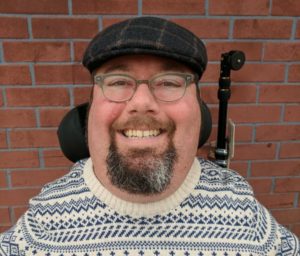
Voting, the most fundamental level of civic participation, is often considered something that is fairly straightforward. That is, until it isn’t. For those of us in the I/DD and larger disability communities, it’s much like the rest of life – an opportunity to encounter and challenge barriers.
However, in five SB 450 “Voter’s Choice Act” (VCA) implementation counties – Sacramento, San Mateo, Nevada, Napa and Madera – everything was different. On the face of it, the changes for some, were, again straightforward: All voters received a mail-in ballot (this change was in all counties statewide) and… (From here forward, I will provide you with a reading soundtrack recommendation: “Changes” by the late David Bowie.) The VCA pilot counties became an “All-Mailed Ballot/Vote Center Election Model.”
That last bit, the “Vote Center” part essentially meant that places where ballots would be cast, formerly known as polling places, were going to be dramatically different. Some of them would be open for as many as 11 days, and others for four. All of them would have at least three fully accessible ballot marking machines. The vote centers were required to be, when possible, located near public transportation. And on the “vote by mail” side, voters with disabilities have the opportunity to access a “Remote Accessible Vote by Mail System” (RAVBM) to provide an opportunity for increased privacy and accessibility for mailed ballots.
I was fortunate in that I had a history as a disability rights advocate and past president of Disability Organizing Group For Initiating Total Equality (DOGFITE), and had met Dr. Mindy Romero, Director of the California Civil Engagement Project and unquestionably California’s rockstar voter engagement policy wonk. Several years ago, Dr. Romero planned a public opinion research opportunity on disability voting access, convened by Ted Jackson, Community Organizer with the DONetwork (a statewide independent living advocacy network) for persons with disabilities. I was lucky to be a part of that table.
As you might be able to tell, my first year as Director of Advocacy Services at Resources for Independent Living has given me a crash course in voting advocacy for people with disabilities. Previously, my knowledge had been limited to my own experience with physical barriers at a polling place: a closed, non-accessible exterior door. One of my first times voting in California, I also had to wait about a half-hour while the single accessible ballot marking machine was set up, because no one had requested use of it.
Now I know that the most locally-powerful, influential advisory body is the county’s Voter Accessibility Advisory Committee (VAAC). These committees offer direct input to the counties’ Election Administration Plans. This is the room that all persons with disabilities interested in voting accessibility should absolutely be in. Some counties may not yet have VAACs that are active, and others may still be unaware that the word on the street is California Sec. of State Alex Padilla hopes to have the VCA model deployed statewide by 2020. And even after the changes in the pilot counties, a closed door can still be an issue. (My closest Vote Center did not have an ADA power-assisted door opener… Thankfully, I knew to call the county’s Registrar of Voters!)
I also know that change can be good. It felt empowering to be able to use a ballot marking machine that was just like every other ballot marking machine in the room: accessible. The results from the changes are also encouraging. The increase in turnout compared to 2014 (also a nonpresidential election year) between the five pilot VCA counties averaged 12.95% according to data from the Secretary of State’s office. Here in Sacramento County, voter turnout was 41.9%. Impressive for a nonpresidential election.
The real story is still ours for the making, however. The new VCA changes are an absolute positive shift toward increased accessibility.
“In Colorado, they went to a system similar to [the Voter’s Choice Act], and their turnout in 2016 was 69 percent,” Jackson said. He added he is looking forward to seeing numbers for voter turnout for people with disabilities in VCA pilot counties.
“I’m feeling very positive, actually,” Jackson said.
I am also looking forward to the future. Here in Sacramento County, we’ve got a chance to further expand access, to grow from lessons learned and improve the VCA model for November’s election. But we need engagement from our community in order to succeed. We need to hear stories about voting accessibility barriers. We need our community to be present in VAACs (and Language Accessibility Advisory Committees [LAAC] too!). We need to hear you.
“There is a whole lot of work that REV UP! has done to mobilize the disability community,” Jackson said. ” I feel like everywhere folks are mobilizing. Voter turnout is getting more familiar for grassroots disability organizations, so it’s getting easier to fit in their plans.”
It’s true. The ability to use a computer with assistive technology from home to independently mark a mail-in ballot or visit a Vote Center and use an accessible ballot marking device – in some places, more than a week before “Election Day” – means increased access for our community.
But sometimes there can still be a closed door in the way. Barriers to voting access, and the real truth is that election policy and access is subject to change – just like everything else – motivated my desire to engage. If we can all take a seat at the table and have our voices heard, together, the future of California’s elections will be increasingly accessible to all.

Guest Columnist Russell Rawlings, Director of Advocacy Services, Resources for Independent Living
